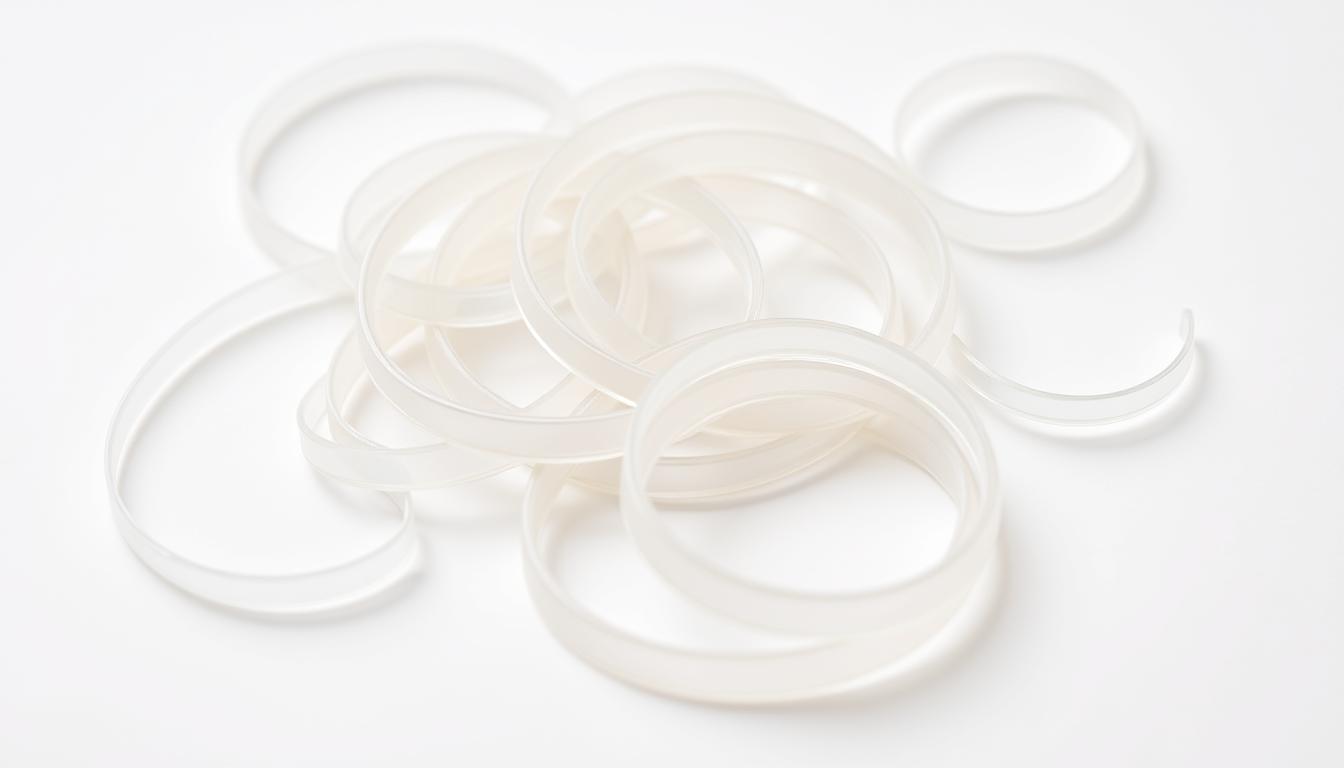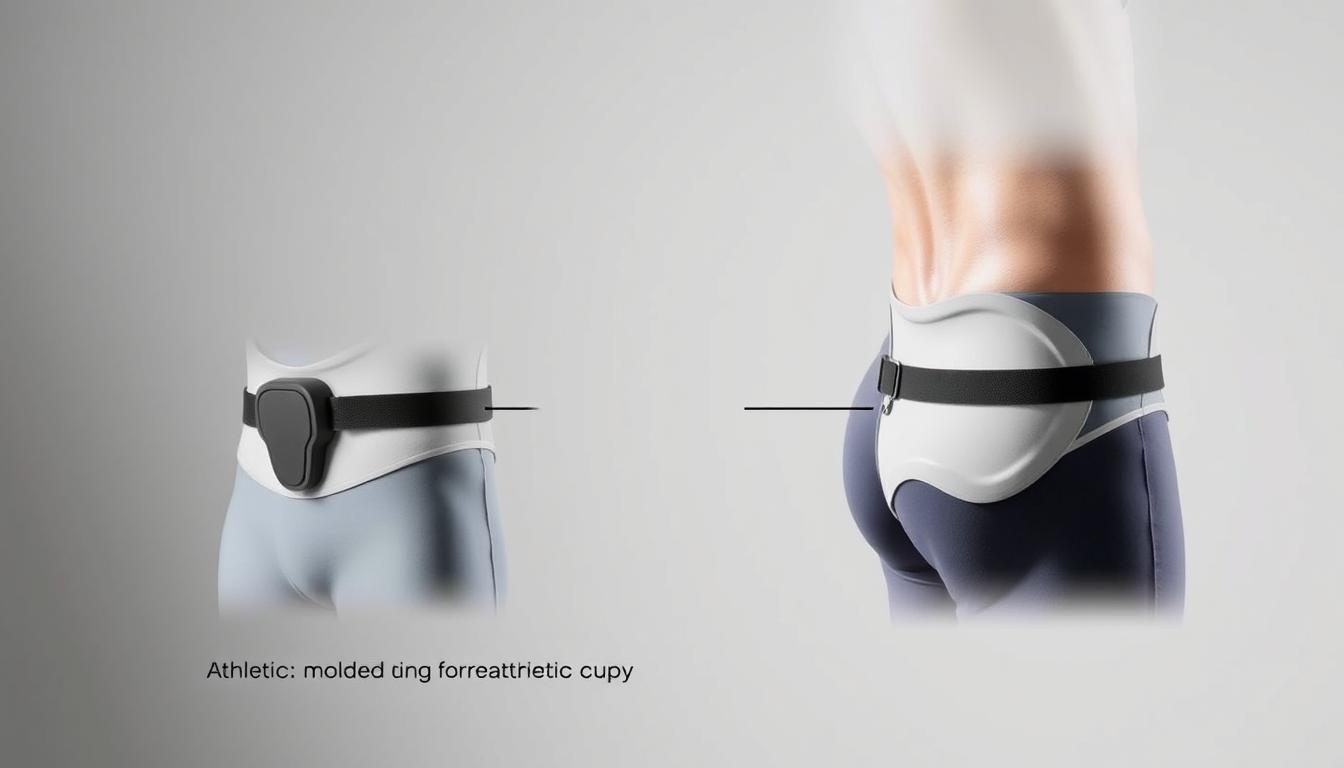Orthodontic treatment can seem daunting, like figuring out how long to wear rubber bands for an overbite. Your path to a perfect smile needs careful planning and dedication.
Orthodontic rubber bands are key in fixing dental alignment. They help you get the smile you’ve dreamed of. The time you wear them depends on your overbite’s severity and how well you follow your treatment plan.
Patients often ask about how long they’ll wear rubber bands. This time can be anywhere from a few months to two years. Your orthodontist will set a timeline just for you, based on your dental needs. Sticking to your treatment plan is essential.
Each rubber band set is like a tool, moving your teeth and jaw into the right spot. It takes patience and careful use, but the outcome can change your smile and dental health a lot.
Key Takeaways
- Rubber band duration varies by individual dental needs
- Treatment typically lasts between 6 months to 2 years
- Consistent wear is critical for successful correction
- Personalized treatment plans determine exact duration
- Regular orthodontist check-ups monitor progress
Understanding Overbite and the Role of Rubber Bands
Correcting an overbite is key in orthodontic treatment. It helps patients get a balanced and healthy smile. Rubber bands are a great way to fix jaw positioning and improve looks.
Orthodontic issues vary, and knowing about overbites is important. These problems can affect both health and confidence.
Types of Overbites Requiring Rubber Bands
Not all overbites are the same. Orthodontists find different types that need rubber bands:
- Vertical overbites with significant jaw overlap
- Skeletal overbites involving jaw structure
- Dental overbites related to tooth positioning
- Moderate to severe alignment issues
How Rubber Bands Work with Braces
Rubber bands are a strong tool for moving the jaw. They help patients slowly move teeth and jaw into the right place.
Benefits of Using Rubber Bands
Rubber bands do more than just make teeth look good:
- Precise jaw alignment
- Improved bite functionality
- Enhanced facial symmetry
- Non-invasive correction method
Overbite correction rubber bands are a game-changer for dental health. They give patients a chance to change their smile with little effort.
The Average Duration of Rubber Band Treatment
Starting rubber band treatment for an overbite can be a journey. The time needed varies based on your dental needs. Most people can expect a certain time frame for their orthodontic correction.
Usually, patients wear rubber bands for 6 to 12 months. Knowing how many hours a day to wear them is key. Orthodontists often suggest:
- Wear rubber bands for 22 hours a day for best results
- Keep them on and off as directed
- Follow your orthodontist’s advice closely
Your treatment plan will be tailored just for you. Several things can affect how long you’ll need treatment, including:
- The severity of your overbite
- Your age
- How well you follow your orthodontist’s advice
- Your jaw and teeth alignment
Expect to see progress over time. Regular visits to your orthodontist will show how well the treatment is working. Some people might see changes sooner, while others might need more time.
Being patient is important. The aim is to get your teeth perfectly aligned. This requires time and commitment to your treatment.
How Long Do You Have to Wear Rubber Bands for Overbite
Correcting an overbite can seem complex. The time you wear rubber bands for an overbite varies. It depends on several important factors. We aim to make the treatment process clearer and help you know what to expect.
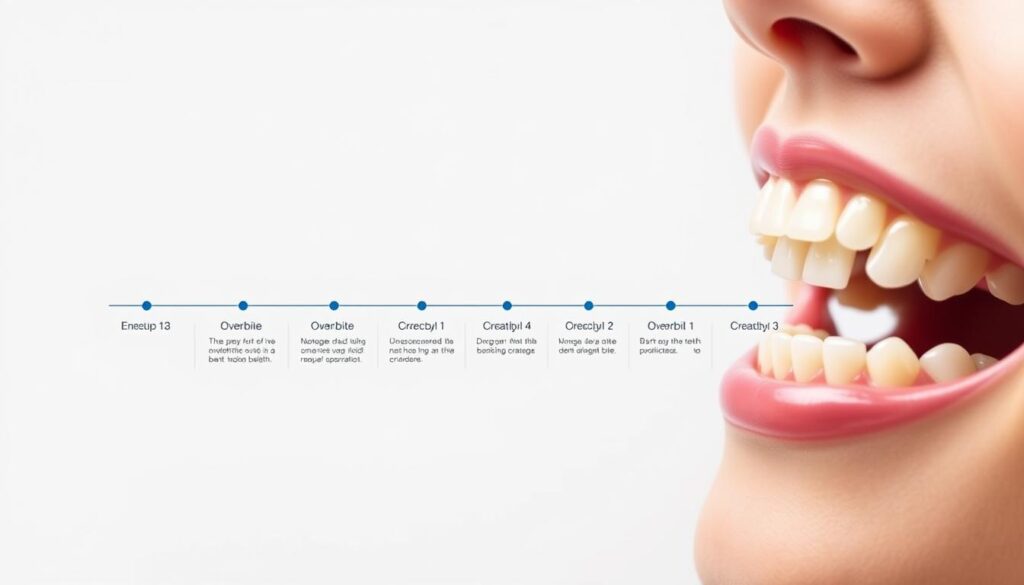
Factors Influencing Rubber Bands for Overbite Length
Several things affect how long you’ll wear rubber bands for an overbite. Knowing these can help you have realistic hopes:
- Age of the patient
- Severity of the overbite
- Patient compliance
- Individual jaw structure
- Overall orthodontic treatment plan
Treatment Duration Breakdown
The time you wear rubber bands for an overbite usually ranges from 6 to 12 months. Individual experiences may vary. Here’s a detailed look at treatment times based on overbite severity:
| Overbite Severity | Estimated Wear Time | Additional Considerations |
|---|---|---|
| Mild Overbite | 6-8 months | Minimal jaw correction needed |
| Moderate Overbite | 9-12 months | More significant jaw repositioning |
| Severe Overbite | 12-18 months | Extensive orthodontic intervention |
Your orthodontist will give you a personalized plan for wearing rubber bands. It’s important to wear them consistently and follow their advice for the best results.
Daily Wear Requirements for Overbite Rubber Bands
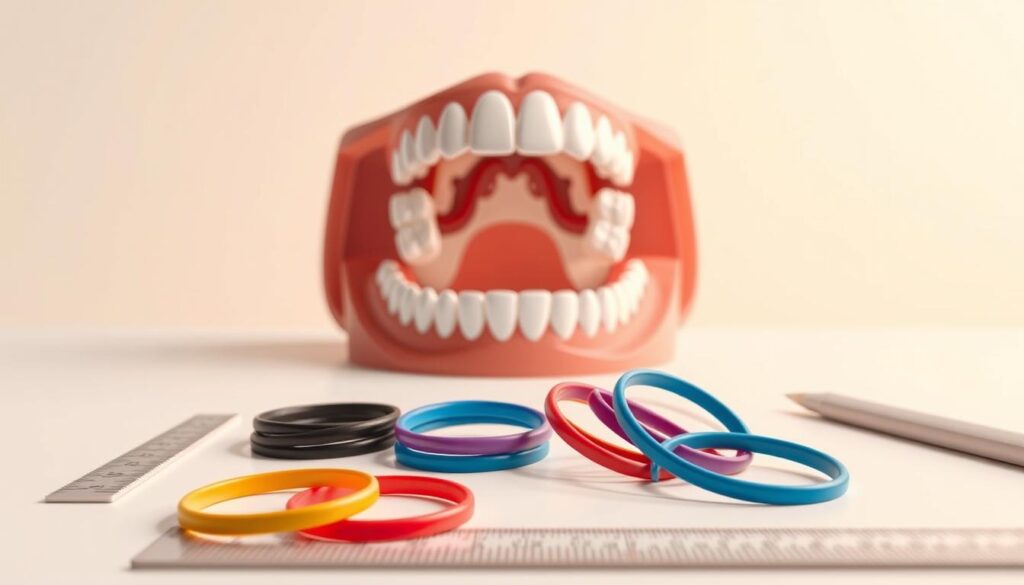
Learning the overbite rubber band wear schedule is key for good orthodontic treatment. Wearing rubber bands is important for fixing teeth alignment and getting the best results.
Orthodontists usually tell patients with overbite to follow a daily routine. This routine often includes:
- Wearing rubber bands 20-22 hours a day
- Keeping them on while awake and asleep
- Removing them only when eating and brushing teeth
Knowing how long to wear rubber bands for overbite correction takes time and effort. Think of rubber bands as your teeth’s personal fitness trainers – they work all day to change your teeth’s shape.
| Time of Day | Rubber Band Wear Recommendation |
|---|---|
| Daytime | Continuous wear except during meals |
| Nighttime | Keep bands on while sleeping |
| Eating/Brushing | Remove and replace immediately after |
Many ask about how long rubber band treatment lasts. Most orthodontists say it takes 6-12 months. Your exact time depends on how bad your overbite is and how well you stick to the wear schedule.
Pro tip: Use phone reminders or a tracking app to keep up with your rubber band routine. Staying consistent is vital for the best orthodontic results.
Proper Application and Removal of Orthodontic Rubber Bands
Learning to wear rubber bands for overbite correction needs care and precision. Our guide will show you how to place orthodontic rubber bands with confidence.
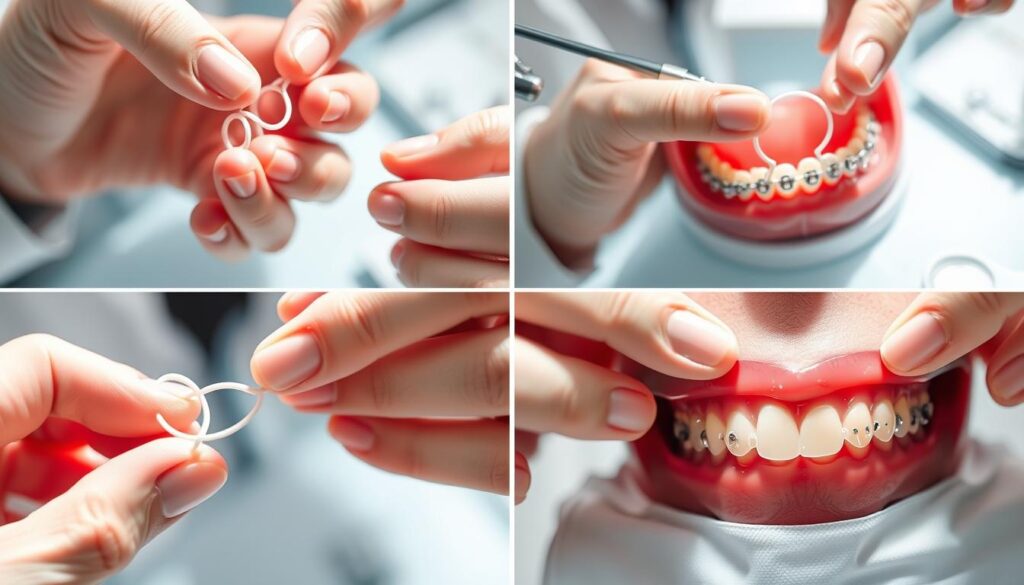
Orthodontic rubber bands are key in fixing dental alignment. Knowing how to apply them correctly can greatly improve your overbite treatment.
Step-by-Step Rubber Band Placement Guide
- Wash your hands well before touching rubber bands
- Find the right hook spot on your braces
- Stretch the rubber band softly between your upper and lower brackets
- Make sure it’s even on both sides of your mouth
- Change bands as your orthodontist tells you to
Critical Mistakes to Avoid During Orthodontic Rubber Band Treatment
- Incorrect stretching that messes up band placement
- Wearing bands for the wrong amount of time
- Not keeping up with oral hygiene during treatment
- Missing band replacement appointments
| Rubber Band Type | Daily Wear Time | Replacement Frequency |
|---|---|---|
| Light Tension | 20-22 hours | Every 24 hours |
| Medium Tension | 18-20 hours | Every 12-24 hours |
| Heavy Tension | 16-18 hours | Every 8-12 hours |
By sticking to these tips for wearing rubber bands for overbite, you’ll get the most out of your treatment. You’ll also avoid any problems.
Signs Your Rubber Bands Are Working Effectively
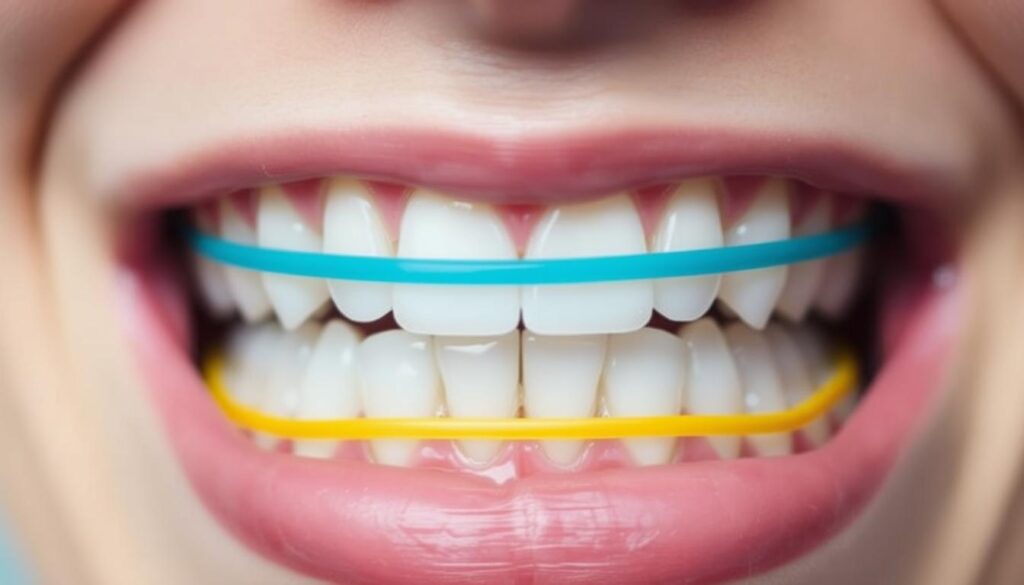
Watching your overbite correction rubber bands work is thrilling. Your journey to a straighter smile is filled with small but important changes. These changes show your treatment is going well.
Seeing how well rubber bands work for overbite treatment takes attention. Look for these signs to know your treatment is on track:
- Gradual Bite Alignment: Your teeth start shifting into their correct position
- Reduced gap between upper and lower teeth
- Improved facial profile symmetry
- Increased comfort when biting and chewing
Seeing changes in your teeth is key to tracking your progress. You might notice:
- Teeth appearing more evenly spaced
- Reduced overlapping of front teeth
- More balanced jaw positioning
Your orthodontist will check on you often to see how things are changing. They can tell you for sure if the rubber bands are working.
Keep up with wearing your rubber bands. Every little change brings you closer to your dream smile.
Potential Challenges During Rubber Band Treatment
Orthodontic rubber bands are key for fixing overbite issues. But, they also bring their own set of challenges. Knowing how long to wear them and dealing with discomfort can make your treatment easier.
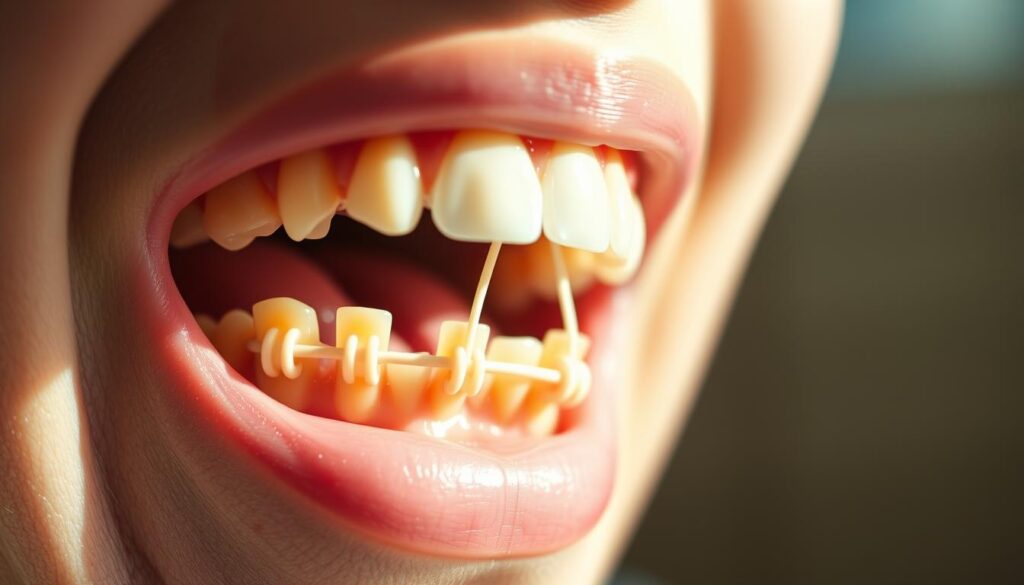
Every person’s time wearing rubber bands for overbite is different. It’s normal to face some challenges. Let’s look at the common issues you might run into during your treatment.
Navigating Initial Discomfort
When you first start wearing rubber bands, you’ll feel some discomfort. It takes time for your mouth to get used to the new pressure and position. Here are some tips to help with the initial pain:
- Use over-the-counter pain relievers before changing bands
- Apply orthodontic wax to reduce friction
- Stick to soft foods during the first few days
- Practice gentle jaw exercises recommended by your orthodontist
Combating Rubber Band Fatigue
Wearing rubber bands for overbite can be tiring. Your mouth muscles might get tired, and you might feel some jaw tension. This is all part of the process.
- Take short breaks between band changes
- Practice relaxation techniques for jaw muscles
- Use warm compresses to soothe muscle tension
- Maintain consistent wear to minimize prolonged discomfort
Pro tip: Always talk to your orthodontist about any ongoing pain or challenges during your treatment.
Impact of Patient Compliance on Treatment Success
Wearing rubber bands for overbite correction is key to getting the best results. How well you follow your treatment plan is very important. This is true, even more so when using rubber bands to fix alignment issues.
The schedule for wearing overbite rubber bands is not just a suggestion. It’s a vital part of your treatment plan. Using rubber bands correctly and consistently helps move your teeth and jaw into the right position.
- Wear rubber bands exactly as prescribed by your orthodontist
- Follow the recommended rubber bands for overbite length schedule
- Replace bands regularly to maintain consistent tension
Patients who stick to their wear schedule usually see better and faster results. Not wearing them as directed can make treatment take longer. It might even affect how well your teeth and jaw line up in the end.
| Compliance Level | Treatment Impact | Estimated Time Effect |
|---|---|---|
| High Compliance | Optimal Jaw Alignment | Shortest Treatment Time |
| Moderate Compliance | Partial Correction | Extended Treatment |
| Low Compliance | Minimal Progress | Significantly Delayed Results |
Pro tip: Set reminders, use tracking apps, or create a daily routine to ensure you’re consistently wearing your rubber bands as prescribed. Your future smile depends on your current commitment!
Dietary Considerations While Wearing Rubber Bands
Wearing rubber bands for an overbite means you need to plan your diet carefully. What you eat can really affect how well your orthodontic treatment works. It’s important to know how to eat while wearing rubber bands to fix your overbite right.
Some foods can be tricky to eat with rubber bands. It’s smart to pick your meals wisely to help your treatment go smoothly.
- Soft foods are your best friends during rubber band treatment
- Avoid sticky and hard foods that can damage rubber bands
- Cut food into smaller, manageable pieces
- Remove rubber bands before eating
How long you wear rubber bands affects what you can eat. Usually, orthodontists say to take them out while eating. This keeps them from getting damaged and losing their stretch.
Here are some foods that are good for patients wearing rubber bands:
- Smoothies and protein shakes – Easy to consume
- Mashed potatoes
- Yogurt
- Scrambled eggs
- Soft cooked vegetables
But there are foods you should avoid:
- Chewy candies
- Hard nuts
- Tough meats
- Crunchy chips
- Whole apples
Always brush your teeth well after eating. And make sure to change your rubber bands as your orthodontist tells you to. Taking good care of them helps your treatment work best.
Combining Rubber Bands with Other Orthodontic Treatments
Overbite correction rubber bands are key in orthodontic treatment. They work well with different dental methods to align your smile perfectly. These small elastics are vital in changing how you approach dental alignment.
The time you wear orthodontic rubber bands can change based on your treatment. You have many ways to fix your dental alignment:
- Traditional braces with rubber bands for extra support
- Clear aligners with rubber bands for better results
- Hybrid treatments that mix different orthodontic methods
Integration with Braces
Rubber bands are a must with traditional braces. They act like strategic connectors, helping move teeth and fix jaw alignment. Orthodontists design rubber band setups to tackle specific dental problems.
Alternative Treatment Options
There are new ways to use overbite correction rubber bands. Some include:
- Custom elastic designs
- Advanced biomechanical techniques
- Personal rubber band wear plans
We create a plan that fits your unique dental needs and goals. Every treatment is as unique as your smile.
Post-Treatment Care and Maintenance
Finishing your rubber bands for overbite treatment is a big deal! Your new smile needs special care to stay perfect. This helps avoid any changes in your teeth’s alignment.
Once you remove your overbite rubber bands, your orthodontist will give you important steps. These steps help keep your smile looking great:
- Wear a custom-fitted retainer as instructed
- Schedule regular follow-up appointments
- Maintain excellent oral hygiene
- Avoid habits that could compromise tooth alignment
Your overbite rubber band treatment doesn’t stop after you remove them. Retainer compliance is key to keep your teeth in place. Most people need to wear retainers all the time at first. Then, they switch to wearing them only at night.
Patients usually follow a specific plan for wearing retainers:
- First 3-6 months: Full-time retainer wear
- Next 6-12 months: Nighttime wear
- Long-term: Periodic retainer use as recommended
Seeing your orthodontist regularly is important. It helps keep your smile perfect. Your orthodontist can check on your progress and make any needed changes.
When to Contact Your Orthodontist
Managing your overbite rubber band wear schedule needs clear talk with your orthodontist. Knowing when to call them can greatly affect your treatment’s success and your experience.
During your overbite treatment, there are important times to reach out to your orthodontist:
- Persistent pain or discomfort beyond normal adjustment periods
- Unusual shifting or movement of teeth that feels different from expected progress
- Difficulty maintaining your overbite rubber band wear schedule
- Broken or damaged orthodontic equipment
- Questions about how long you have to wear rubber bands for overbite correction
Early intervention can prevent possible complications and keep your treatment on track. If you face any unexpected issues during your rubber band treatment, don’t wait to book a consultation.
Your orthodontist can give you tailored advice on your overbite rubber band wear schedule. They know the detailed needs of each treatment plan and can answer any questions about your progress.
Remember, getting professional advice is key to the best results for your orthodontic journey. Regular check-ins and open communication will help you move through your treatment with confidence.
Conclusion
Getting an overbite fixed with rubber bands takes time, effort, and a positive outlook. Our guide has given you the key to how these bands can change your smile.
These rubber bands are more than tools; they’re your smile’s architects. Every time you wear them, you’re moving closer to a perfect smile. Following your orthodontist’s advice is key to success.
Every person’s journey to a perfect smile is different. It might be tough, but the end result is worth it. A confident, aligned smile shows your style and hard work.
Knowing how rubber bands work is a big step towards better dental health. Enjoy this journey, knowing you’re getting closer to your dream smile every day.

